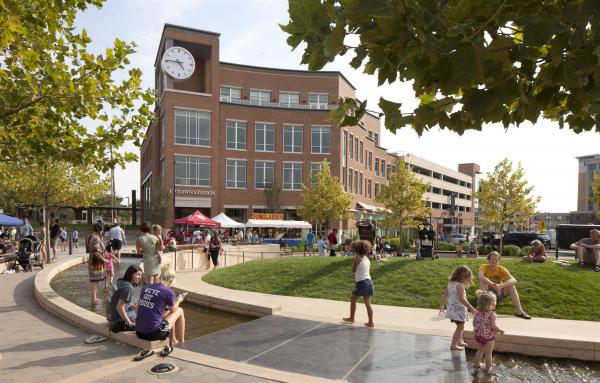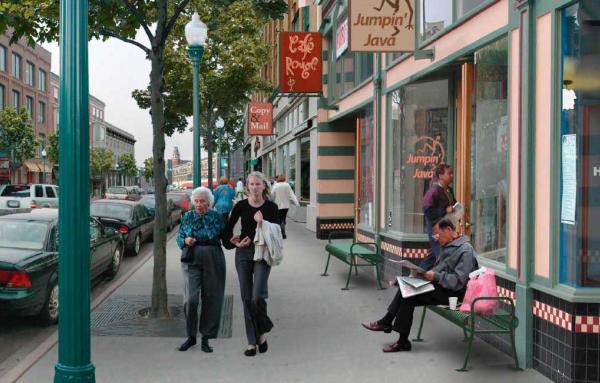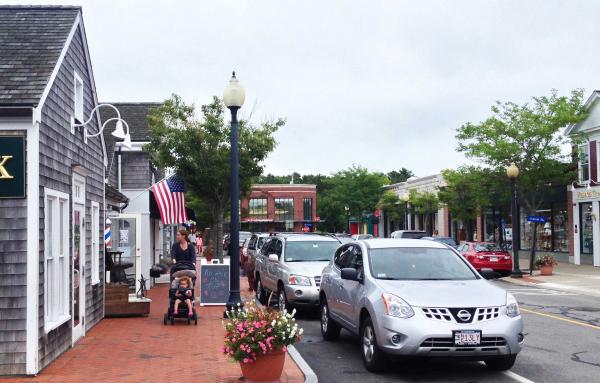
Great Idea: Context-based street design
In celebration of the 25th Congress for the New Urbanism, Public Square is running the series 25 Great Ideas of the New Urbanism. These ideas have been shaped by new urbanists and continue to influence cities, towns, and suburbs. The series is meant to inspire and challenge those working toward complete communities in the next quarter century.
For much of the last century, thoroughfares were designed for maximum motor-vehicle mobility, often making cities and towns dysfunctional for people outside of cars. In walkable neighborhoods and centers, streets are public spaces that serve multiple social and economic functions while contributing to the beauty and character of a community. Such thoroughfares include main streets, boulevards, avenues, "shared space" streets, and local streets designed for slow traffic speeds. As more communities seek better balance between cars and people, context-based street design is making inroads—among transportation engineers, planners, public officials, and citizens.
Public Square editor Robert Steuteville interviewed Dan Burden, walkability expert and Director of Inspiration and Innovation at Blue Zones, and Wesley Marshall, associate professor of civil engineering at the University of Colorado at Denver, on the subject of context-based street design.

What does context-based street design mean to you and why is it important?
Burden: First and foremost, streets should be responding to what the land-use is, what the needs are for the neighborhood, the commercial district, or the rural area. Too many times we have designed streets based on one format fits all. We need take into consideration many things—including placemaking, whether people will walk or bicycle, the target speed, the climate region, shade and greening—before we even think about designing a street. And if we modify a street that already exists, then we have to understand what this urban area wants to become and then design the street so that it enhances and serves as a catalyst—knowing that we often end up destroying neighborhoods if the speeds and the support for regional traffic are too high.
In the past, we designed streets for efficiency, maximizing movement, and that often would induce speed. But in the future, streets are going to have to bring speed down to what is appropriate for their space, as appropriate to context. We also need to build homes and other buildings that watch over the street to provide security. Only if we do that are people going to feel comfortable walking again.
Marshall. This whole concept emerged from an over-emphasis on moving traffic. Now we need to focus much more on how streets contribute to the social, the economic, and the environmental aspects of our cities. How can streets be a destination in themselves? I've always said New Urbanism is less about architecture than it is about transportation and community design. If you get the architecture right and the streets wrong, your place doesn't work. On the other hand, if you get the architecture wrong and the streets right, your place still has a pretty good shot of succeeding. The key to all that is really just making sure the streets match the context. Or better yet, like Dan was alluding to, that they match the context of what you want the place to be. It's about matching the dimensions, the street networks, the car speeds, the street trees, the parking, and even the building placement to place. For too long we've done it the opposite way where we've designed for cars first and worried about the other stuff later, if ever.
How does the new urban idea of context based street design differ from what engineers and transportation planners have been doing for the last 60 or 70 years?
Marshall: From the 1930s or so, we've been using the AASHTO Green book which has the two axis, we have mobility on one side and we have access on the other and we end up with a pretty limited matrix of options. In terms of context, there was a binary option: It's either urban or rural. That’s not even close to the way the world works. In the 1980s the traffic calming movement started to get legs, and then in the late 90s, context sensitive solutions work began. Neither did a great job helping us build better cities. In 2006 CNU and the Institute for Transportation Engineers came out where with Designing Walkable Urban Thoroughfares, and applied context sensitive design to the streets and networks. I've seen the way that other countries in Europe have looked at functional classification system and instead of a binary system they'll have a matrix of 25 or 30 options. In India, it's something like 59 different options for roads. That gives engineers more options for design.

Burden: When context sensitive street design first came about, we still weren’t recognizing the depth of our problem. Now we're finally starting to understand that land use and transportation should be united. I've advocated for a long time that that street design and traffic engineering should be under community development—that we need to change the whole emphasis of why we invest in streets. And that's not going to happen if we keep our traffic engineering in public works as the chief organization.
Engineers are prone to thinking about streets in certain ways. And they're in control of street design. Can we get beautiful streets that we want under the current system?
Marshall: One of the problems is the limited toolbox we give engineers. The multiway boulevard is a good example. It’s not been used recently because it doesn’t fit into the functional classification system.
Burden: The depth of our problem is in the core ways that we have funded transportation projects. This is an institutional problem. We know how to design better, and more appropriate streets. It’s the funding forces, and the expectations, we have institutionalized. There's only one solution that is allowed. It gets back to the question: “Why are we investing in our streets the way we are?” If we take a walk through Boston or Cambridge or any place that where we love the streets and then try to replicate those streets we find out that the institutions either can't fund it or they've got so many rules that they will spend their time and money attempting to break the rules instead of coming up with a design.
Marshall: Our inability to fund good streets is one of the reasons the whole tactical urbanism movement has become so powerful. The disconnect when you walk through a lot of cities between our streets and our places is readily apparent, not just to professionals like us, but to anybody. And instead of waiting for a multiyear planning project to tell them what to do, risk the chance of that paper sitting on a shelf collecting dust somewhere, people want to get out and see what works. Because there's no funding for it anyway, you can do it much cheaper and easier, and you actually get to test something on the ground.
One thing that bothers me about the concept of complete streets is that sometimes designers use conventional techniques, but they add a bike lane, or sidewalks and crosswalks. So the complete streets are treated as add-ons rather than rethinking the basic design. Is that your experience?
Burden: Yes. We ask everyone to go down their checklist, make sure we're moving the traffic, we're not creating any bottlenecks or impacting level of service, all those things. Only then do we say “oh, by the way, make sure you don't forget the pedestrian.” If we worked the other way around and said, number one, your designs have to be place-and people based, focused on what the neighborhood wants to become, and how you're going to get it there. Once you've accommodated people, do the best job you can not to mess with traffic too much. But that's part of the area you're going to forgive. Right now, we forgive the designer if they can't quite figure out how to get the pedestrian in. In the future, what we're going to need to move to building the place for people. Right now, Honolulu Hawaii is doing a set of complete streets projects. And they're starting by building an appropriate multimodal level service and then if there are negative effects of traffic, talking about how to mitigate for that. The number one goal is to design a perfect place first.
Marshall: When I was in Australia, I was able to study the Smart Roads framework that they using. The name connotes something high-tech, but it really isn't. It's really just network planning by modes. They use a multi-modal level of service, and they decide which roads should prioritize different modes. So, one road might prioritize transit. Another one might be for bikes, another pedestrians, and cars. And they do this whole network planning exercise where they fit the roads to the surrounding context.
So how much impact has the New Urbanism had so far on those who are in charge of street design?
Burden: I don't think we're having the impact we need yet. When you break down populations of change agents, maybe 10 percent are out there bringing the change, and there are 10 percent that are going to resist it no matter what, and the other 80 percent are waiting for the pioneers to prove that things work. Once we have more proof financially and get some momentum going, I think we're going to see the other 80 percent jump on.
Marshall: If you would review those same cities, most of them will probably say they're influenced more by NACTO (National Association of City Transportation Officials) and their more recent design guidelines – which CNU has influenced quite a bit in recent years. So it’s getting to cities to some extent.
So the corollary to that is how much more is there left to do? And from Dan's perspective, a whole lot more.
Burden: We still have many more to influence. I worked in government for 16 years so I know how hard it is to get that ship turned into a new direction. But again, I don’t think we have to capture more than 10 percent. Once we do, the whole world's going to shift. Once you start a new movement that really has energy behind it, they're never going back to the old ways.
Marshall: I just think we sold some inherent problems that underlie a lot of what we're doing. A lot of places would be more than happy to do a context sensitive street design. But at the same time, they have these regional traffic demand models that are telling them they're going to have 30,000 or 40,000 cars per day on some major road in the year 2040. They treat those numbers like they're set in stone, but they are not set in stone. Those numbers could come to fruition if you re-design the road to accommodate that amount of traffic. If that road cuts a neighborhood in two, it isn’t the road that we want. And we have the methods to design the road to accommodate the level of traffic that the stakeholders see fit.
Burden: Many communities have comprehensive plans that aspire to something, but their budgets, their policies, their codes are aligned in to meet the old paradigm. If you're serious about context-based design, you have got to start reallocating your funds. You've got to write your code in a way that doesn't incentivize the thing you're trying to get away from.
It seems to me that there's still a reflexive default to use “forgiving design” that gives motor vehicles extra room and eliminates vertical elements near the thoroughfare. Doing that in an urban place is dysfunctional.
Burden: We are seeing progress on a number of fronts. The State of Florida Department of Transportation has a new document (Complete Streets Implementation Plan) that is going to a final review, but I think it will be published January 1st. It sets new defaults. For streets with speeds under 40 or 45 miles per hour, the default lane width will be 10 feet. The engineer has permission to increase the lane width for high bus or industrial traffic, but they have to write a memo to justify making the lanes bigger and wider. That’s moving in the right direction. The Europeans, and Australia as well as New Zealand, are so far ahead of us on this. They go for beauty. And they're trying to do everything they can to bring the target speed down. Our engineers have been schooled in trying to leave everything back to the clear zone so people can go faster. When CNU worked with ITE on the Designing Walkable Thoroughfares Manual I first heard the term ‘target speed.’ I make sure that is in the literature of some of the cities I work in. You start with target speed, and vertical elements do you need to achieve it? What curvatures and curb radii do you need? Will on-street parking help bring down the speed? Eventually we can get beyond the group of folks in the city that are worried about tort liability, and maybe even reverse that, and say, "Look if you're quest or goal is to get the state down to 30, and you continue to operate your streets at 40, what are you doing wrong?" And possibly, you'd end up in court because you're able to prove that the design was functionally wrong.
Marshall: Part of that goes back to the Green Book and the psychology of the way they present those numbers, like they say minimum lane width and minimum right-of-ways. Everything is presented as a minimum, which implies that's the least we can do, that more is better. We need to change our phrasing, whether it's the target speed or whether we say, "10 is what we want for lane width, and if you want to go bigger, you need to have an exemption." It's a different way of presenting it, and it could have a big impact.
Can you think of great examples of innovative or good street design to show how people can do it better?
Burden: The town of University Place, Washington, put together a whole series of designs for a street called Grandview Drive, about two and a half miles long, and it goes through six different typical sections. Their quest in every case was to get the target speed to 30, and to really accelerate the beauty of the street, to bring back walking, bicycling, and add value to all the homes.
Marshall: At CNU a while ago, Andres Duany mentioned US 50 in Washington DC, and how outside of the city it's a limited access highway, but the character changes when you start getting into DC. It eventually becomes New York Avenue, which is still an arterial but it does a much better job of fitting the context than a highway would.
I wanted to come back to the idea of aspiration. Our metro areas are about 90 percent more suburban fabric rather than urban and walkable. So we have so many streets that need to change if people want to achieve sense of place or walkability in the suburbs. The transportation engineer may say, "Well, this a suburban place,” and design the street accordingly. How do we get beyond this chicken and egg problem?
Burden: There's a project that's going on in Fort Worth Texas right now—West 7th street fits between two pretty good areas that are trying to revitalize. The goal is to change it from an ugly five-line strip corridor into a beautiful street that's going to set the stage for economic investments. This is one of those places where a model project will enable people to say, "Hey! It worked!"
Marshall: It's not sustainable to keep funding this suburban thing, especially if there's a community that wants something different. We shouldn't keep pouring dollars into what we have on the street. That money is much better spent on lower hanging fruit like sidewalks and street trees. Narrowing streets doesn't have to be a major infrastructure development. A whole city can be transformed less than the cost of one highway interchange.







